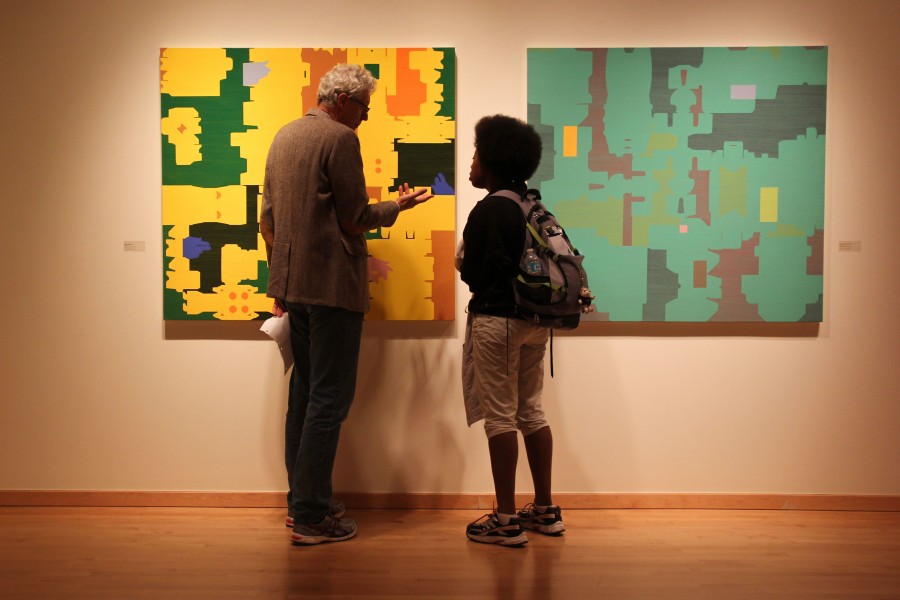Nature, culture, identity: capitalism
Capitalism takes a different form with artist Paul Ryan
Paul Ryan, left, talks with Anthonia Adams about his work hanging in the Staniar Gallery. Photo by Ellen Kanzinger, ’18
September 28, 2015
Capitalism is a tree trunk and an unfolded package of toothpaste, according to painter and artist Paul Ryan.
In order to discuss his career and his collection of paintings, the sun that never sets, that are on display in Staniar Gallery through Oct. 4, Ryan delivered an artist talk to students and locals Wednesday evening in Wilson Concert Hall.
“I believe in art-making as a way of thinking; a means for thinking,” Ryan said. “It is a means for processing and sorting through our experience as individuals socially, culturally, philosophically, politically.”
Recently, Ryan has focused his paintings, particularly his the sun that never sets collection, on combining shapes from nature, such as the contours of tree trunks, with symbols of modern culture, like unfolded light bulb, gum and toothpaste packages, to represent society and capitalism.
“I wanted to emphasize the nature of capitalism: how it is so pervasive, how it affects identity, how we define ourselves,” Ryan said. “I think the paintings that have an aesthetic substance sort of parallel the beautiful quality of capitalism. But I say ‘beautiful’ not without critique.”
Ryan, a Professor of Art at Mary Baldwin College in Staunton, Va., and a contributing editor for Art Papers Magazine, has spent his career as an abstract painter, exploring topics such as the quirkiness of children, negative space and the complexities of living among both nature and culture.
“Paul Ryan is an important artist who has been making valuable contributions as a painter, critic, curator, writer and teacher throughout the Mid-Atlantic region’s art community for 25 years,” Staniar Gallery Director Clover Archer Lyle said. “Paul’s paintings are formally sophisticated and conceptually thoughtful, which makes him an excellent example for our students.”
In addition to the images formed from unfolded packaging, Ryan also incorporated other symbols into his collection, such as the shapes of wedding cakes and an occasional hand, in his paintings to highlight other aspects of today’s culture.
“Even things like love and weddings are all about selling and buying,” Ryan said. “And the hands have to do with the playful passivity that goes along with the passivity capitalism cultivates.”
Several students that attended Ryan’s Talk, such as Kiki Spiezio, ‘17, connected the ideas behind his current work to their own personal experiences with art and society.
“Ryan’s art reminded me of some projects I did in my Printmaking class last fall, especially the way that he used shapes and packaging because I also had a similar idea in one of the projects that I did,” Spiezio said. “I also related to a lot of his themes on capitalism after coming back from my Shepherd Program internship in the Dominican Republic this summer, which focused on poverty.”
Taylor Reese, ‘19, also appreciated Ryan’s effort to use his creative ability to reflect issues and patterns in modern society.
“I really enjoyed the part of his presentation when his work started to move into both art and a social comment, something I strive to do in my own art,” Reese said. “I want people to appreciate my art and learn from it if they can. I think that is a very valuable part of art and why it is so important. We need art to teach us things that we can’t learn any other way.”



